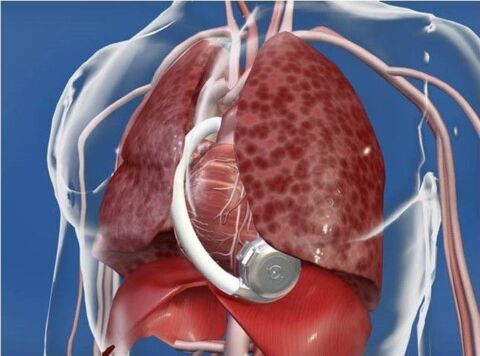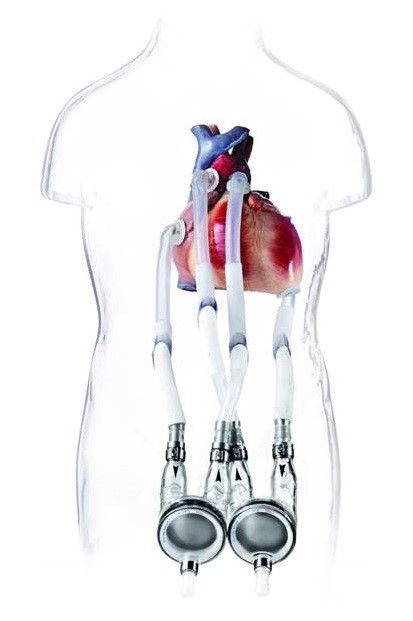Overview
Mechanical circulatory support systems, also known as assist devices, are used for advanced heart failure that is refractory to drug therapy. Various centrifugal pumps are used to support the left heart.
 These centrifugal pumps can be implanted in the pericardium and are connected to the control unit via a thin control cable that is led out through the skin in the abdominal area. This is carried by the patient in a bag, which also contains two batteries that supply the control unit with energy. This means that the patient is completely mobile and can carry out all the usual everyday activities.
These centrifugal pumps can be implanted in the pericardium and are connected to the control unit via a thin control cable that is led out through the skin in the abdominal area. This is carried by the patient in a bag, which also contains two batteries that supply the control unit with energy. This means that the patient is completely mobile and can carry out all the usual everyday activities.
 If the right heart also needs to be supported in addition to the left heart, so-called paracorporeal biventricular ventricular assist devices are used, in which both the right and the left heart are each connected and supported via an inflow and outflow cannula with a pumping chamber. The two pumping chambers are located outside the body on the patient’s abdomen. They are connected to a pneumatic drive unit that the patient carries on a small trolley. Patients are also completely mobile with these systems.
If the right heart also needs to be supported in addition to the left heart, so-called paracorporeal biventricular ventricular assist devices are used, in which both the right and the left heart are each connected and supported via an inflow and outflow cannula with a pumping chamber. The two pumping chambers are located outside the body on the patient’s abdomen. They are connected to a pneumatic drive unit that the patient carries on a small trolley. Patients are also completely mobile with these systems.
Over 100 ventricular assist devices have already been implanted at the USZ in recent years.
Risks and complications
While these systems are very effective in supporting the circulation and can pump high blood volumes of up to 6-7 l/min, complications can also occur. The contact of blood with non-endogenous materials of the systems can cause the formation of blood clots, which on the one hand can impair the function of the pump and on the other hand can embolize into the body organs. To prevent this, patients are treated with medication to thin the blood and inhibit platelets. This in turn increases the risk of bleeding. The “control cable” routed through the abdominal wall from the implanted pump to the outside, which in particular ensures the power supply to the pump, and, in the case of biventricular support systems, the cannulas routed to the outside, lead to a connection between the inside of the body and the skin and its germs, which represents an increased risk of infection of the system. In extremely rare cases, a mechanical or electronic defect may also occur, causing the appliance to stop working.
The ventricular assist devices are traditionally used to bridge the gap until heart transplantation, when patients would otherwise most likely not survive the waiting time until a suitable donor organ becomes available.
For some years now, implantable left ventricular assist devices have also been used as definitive, lifelong treatment (so-called “destination therapy”); this is mainly the case for patients for whom a heart transplant is no longer an option due to age or medical reasons. Heart transplantation remains the only long-term treatment option for many patients in the late stages of heart failure.
 These centrifugal pumps can be implanted in the pericardium and are connected to the control unit via a thin control cable that is led out through the skin in the abdominal area. This is carried by the patient in a bag, which also contains two batteries that supply the control unit with energy. This means that the patient is completely mobile and can carry out all the usual everyday activities.
These centrifugal pumps can be implanted in the pericardium and are connected to the control unit via a thin control cable that is led out through the skin in the abdominal area. This is carried by the patient in a bag, which also contains two batteries that supply the control unit with energy. This means that the patient is completely mobile and can carry out all the usual everyday activities. If the right heart also needs to be supported in addition to the left heart, so-called paracorporeal biventricular ventricular assist devices are used, in which both the right and the left heart are each connected and supported via an inflow and outflow cannula with a pumping chamber. The two pumping chambers are located outside the body on the patient’s abdomen. They are connected to a pneumatic drive unit that the patient carries on a small trolley. Patients are also completely mobile with these systems.
If the right heart also needs to be supported in addition to the left heart, so-called paracorporeal biventricular ventricular assist devices are used, in which both the right and the left heart are each connected and supported via an inflow and outflow cannula with a pumping chamber. The two pumping chambers are located outside the body on the patient’s abdomen. They are connected to a pneumatic drive unit that the patient carries on a small trolley. Patients are also completely mobile with these systems.